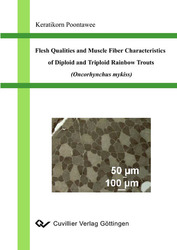| Fachbereiche | |
|---|---|
| Buchreihen (96) |
1379
|
| Nachhaltigkeit |
3
|
| Gesundheitswesen |
1
|
| Geisteswissenschaften |
2367
|
| Naturwissenschaften |
5407
|
| Mathematik | 229 |
| Informatik | 319 |
| Physik | 980 |
| Chemie | 1364 |
| Geowissenschaften | 131 |
| Humanmedizin | 243 |
| Zahn-, Mund- und Kieferheilkunde | 10 |
| Veterinärmedizin | 108 |
| Pharmazie | 147 |
| Biologie | 835 |
| Biochemie, Molekularbiologie, Gentechnologie | 121 |
| Biophysik | 25 |
| Ernährungs- und Haushaltswissenschaften | 45 |
| Land- und Agrarwissenschaften | 1004 |
| Forstwissenschaften | 201 |
| Gartenbauwissenschaft | 20 |
| Umweltforschung, Ökologie und Landespflege | 148 |
| Ingenieurwissenschaften |
1793
|
| Allgemein |
98
|
|
Leitlinien Unfallchirurgie
5. Auflage bestellen |
|
Erweiterte Suche
Flesh Qualities and Muscle Fiber Characteristics of Diploid and Triploid Rainbow Trouts (Oncorhynchus mykiss)
Keratikorn Poontawee (Autor)Vorschau
Inhaltsverzeichnis, Datei (6,4 KB)
Leseprobe, Datei (120 KB)
Flesh qualities and muscle characteristics were investigated in the diploid (2n) and triploid (3n) rainbow trouts (Oncorhynchus mykiss) under normal production (Experiment trout station Relliehausen, University of Göttingen) and commercial production conditions in 2003-2005 year classes. The diploid and triploid fishes were divided into 5 stages by age and body weight. For all flesh qualities the 170 g until portion size (400 g) rainbow trouts the polyploidy induction did not have a great influence on all performances. Only the final body weight and carcass percentage of the third group (75 weeks old) which the triploid fishes were significantly higher than the diploid fishes (390g vs. 430g and 73 % vs. 74 %, respectively). The others qualities, the diploid fishes had better than the triploid fishes such as: a redness value of fillets, water holding capacity and water content in muscle. In the maturing rainbow trouts (95 weeks and 6-7 years old), the parameters were significantly higher in the triploid fishes than in the diploid fishes. The final body weight of the biggest group in the 2n and 3n fishes were 4,200g and 5,900g respectively. Both 95 weeks and 6-7 years old fishes, the redness values were higher in the triploid fishes than in the diploid fishes (12.4 vs. 6.02 and 18.0 vs. 13.8). Also we found better results of WHC, cooking yield and tenderness in the triploid compared to the diploid fillets. As for the pH and EC values from 5 min to 5 hr. after slaughter, there were no differences observed between 2n and 3n. The results did not indicate PSE conditions of the meat. With respect for muscle characteristics significant differences of ploidy fishes were found. In general, white and intermediate muscle fibers areas were bigger in triploid than in diploid fishes. These results were found both in the dorsal and pelvic fins samples. As for the red muscle fibers no clear effect of polyploidy were observed.
| ISBN-13 (Printausgabe) | 3865379893 |
| ISBN-13 (Printausgabe) | 9783865379894 |
| ISBN-13 (E-Book) | 9783736919891 |
| Sprache | Englisch |
| Seitenanzahl | 142 |
| Auflage | 1 |
| Band | 0 |
| Erscheinungsort | Göttingen |
| Promotionsort | Göttingen |
| Erscheinungsdatum | 22.08.2006 |
| Allgemeine Einordnung | Dissertation |
| Fachbereiche |
Land- und Agrarwissenschaften
|








